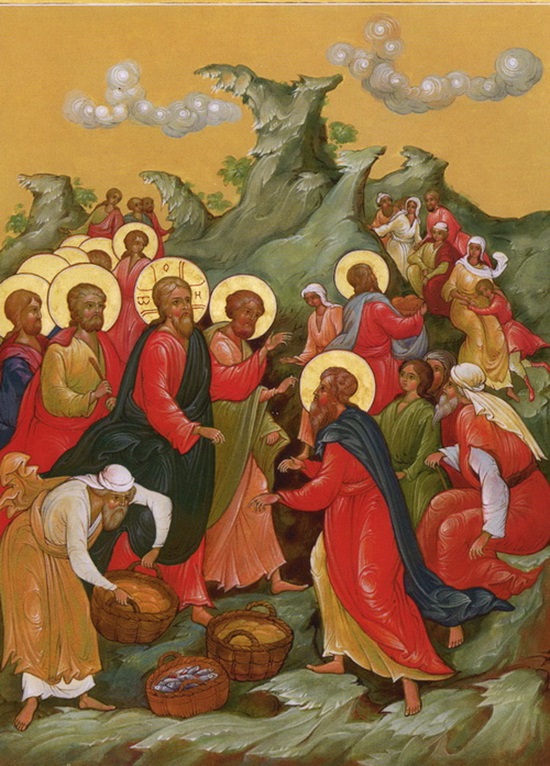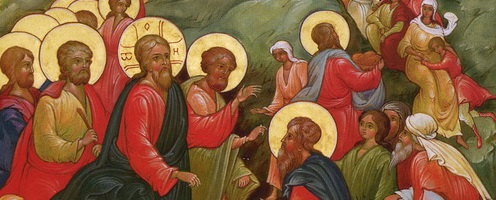Christ Yesterday, Today, and Forever
Seventeenth Sunday Scripture Readings

With today’s gospel passage, our weekly stroll through the gospels detours from following Saint Mark and looks to the commentary on the feeding of the five thousand we find in Saint John’s gospel. Here, we have a three-dimensioned exposé on who Jesus is and what he’s done. Why do I say this narration is three-dimensional? Because, in addition to John’s description of what Jesus said and did, he’s provided us with a reflection back onto the foreshadowing of this event from Israel’s past, and also a prefiguring of what is to come in the life and ministry of Christ’s Church. He shows us, therefore, a God’s-eye view of the past, present, and future in a single narrative.
Whenever John tells us that Jesus “went up on the mountain,” we need always to think of Moses, Mount Sinai, and the people of Israel wandering in the wilderness. The figure of the mountain is a sort of “dog whistle” for those who were steeped in the Torah and the Hebrew Scriptures. Then, when Jesus asked Philip, “Where can we buy enough food for them to eat?” John’s audience recognized Moses’s prayer to God from the Book of Numbers [11:13] when he cries out, “Where can I get meat to give to all these people?” Likewise, when John’s audience encountered Philip’s reply in the gospel, “Two hundred days’ wages worth of food would not be enough,” they doubtless recognized an echo from Moses’s words [Numbers 11:22] when he lamented, “Can enough sheep and cattle be slaughtered for them? If all the fish of the sea were caught for them, would they have enough?”
So, here we have Jesus, the new Moses, leading the new Israel through the wilderness, interceding for them with God to provide for their needs. The people gathered around Jesus, like the people gathered around Moses, were lost. Not only were the Israelites in the wilderness lost, but they were also dissatisfied. They’d been fed mana in the desert but grew tired of it. They wanted more—more food, more variety, and a richer fare. The people following Jesus, too, were hungry for more. They’d seen the powerful signs of healing that Jesus performed, and they came to him so that they, too, could share a piece of the action. They didn’t so much come to him to learn and grow as to find relief and satisfaction.
Therefore, Jesus provides them with a powerful sign—the sign we call the “multiplication of the loaves and fish.” The mechanics of this miracle are open to interpretation. Some think that many in the crowd had brought food with them and that the miracle consisted in the fact that they became willing to share it with one another. Regardless of how we may imagine that the miracle happened, according to all the gospels, it did. And when the disciples gathered up the fragments remaining, John reports that they filled twelve baskets—a description that served to link the twelve tribes of Israel with the Twelve Apostles and the Church they would found and serve.
That link between the people of Israel, the Twelve Apostles, and the Church opens our perspective onto the future. We read that “Jesus took the loaves, gave thanks, and distributed them to those who were reclining.” Wherever in the Christian Scriptures and literature we find the words: “took,” “blessed,” “broke,” and “gave,” we know we are in the context of the Christian Eucharist. Besides here, we find those words in each of the narrations of the Last Supper from Matthew, Mark, and Luke. We find them in Paul’s first letter to the Corinthians [11:23-29]. We find them in the Didache or Teaching of the Twelve Apostles, the first known liturgical text dating from early in the first century and containing the first known eucharistic prayers. And we find them in our own eucharistic prayers and the eucharistic prayers of all liturgical Christian churches.
Notice, too, that John specifies that this event took place when “the Jewish feast of Passover was near.” In other words, this passage from John’s gospel is specifically eucharistic in nature and the multiplication of the loaves and fishes is deliberately meant to prefigure the Christian eucharist.
As we continue our meditation on the eucharist in the weeks to come, we’ll see how this critical message plays out: God cares for us, his people, and satisfies our hunger—not just our hunger for food or even healing—but our spiritual hunger, our hunger for meaning, for love, and for life itself. Like the food given to the children of Israel in the desert, like the food given to the crowds of Jesus’s followers in the wilderness, our spiritual food is taken, blessed, broken, and given to us as gift and without cost or obligation. That’s why we call it “eucharist” which means, simultaneously, “good gift” and thanksgiving for that gift. And so, we offer our eucharist, our thanksgiving, this morning for the incredible gift God has given us that sustained us into life, that sustains us in life even now, and that will sustain our lives forever: Christ’s eucharist past, present, and yet to come.
Get articles from H. Les Brown delivered to your email inbox.
